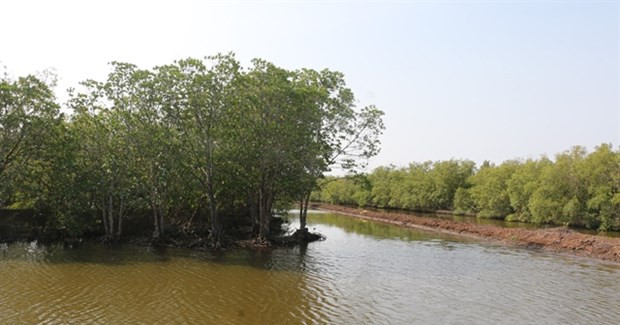Nguyễn Văn Duẩn, deputy director of Quảng Bình Province’s Forest Protection Department, said the province would not only leverage the strengths of natural forests, but also expand its scope, evaluate eligible areas and reduce the potential for of greenhouse gas emissions by implementing new forest plantation activities. according to international standards, converting small timber plantations into larger ones to increase forest carbon reserves in the future.
The province would also hold meetings with relevant organizations and individuals to consult the results of the assessment and propose activities to develop forest carbon credit projects, he said.
The province currently has more than 590,000 hectares of forest, of which more than 469,000 hectares are natural forest. The forest cover rate is 68.7 percent and the forest quality is relatively good.
During the 2023-2025 period, the province received VNĐ235 billion (USD9.25 million) from the sale of carbon credits, providing income to nearly 11,000 forest owners, contributing to sustainable forest management and protection.
Meanwhile, HCM City has been selected as the first place to test the carbon credit trading mechanism.
Specifically, the city will implement potential projects to generate carbon credits, such as upgrading street lighting to LED, installing rooftop solar systems for public and private assets in the area, and equipping buildings with energy-saving devices.
Under this plan, the city’s Department of Natural Resources and Environment will cooperate with the city’s Department of Finance to complete the pilot project on the financial mechanism to implement measures to reduce greenhouse gas emissions through of the trade in carbon credits and compensation mechanisms, and to submit this to the Volksraad. City committee for approval.
In addition, they will work with the Ministry of Industry and Trade, the Ministry of Transport, the Ministry of Agriculture and Rural Development and the Ministry of Natural Resources and Environment to improve the contribution ratio for the reduction and absorption of greenhouse gas emissions within the city area compared to the national economy to decide. target to reduce greenhouse gas emissions before moving to carbon credit trading.
Bến Tre Province in the Mekong Delta currently has the largest coconut plantation area in the country, covering approximately 78,000 hectares.
According to researchers, the province’s area has the potential to store between 1.9 and 5.8 million tons of CO2 (excluding crops under coconut trees).
Recognizing the significant potential of the agricultural sector to participate in the carbon credit market and move towards a green and circular economy, the provincial agricultural sector has focused on continuing to develop environmentally friendly agriculture, circular economy, low-carbon emissions, -friendly and climate-resilient agriculture.
The provincial Ministry of Agriculture and Rural Development has been working with the provincial Ministry of Natural Resources and Environment and relevant agencies to assess the province’s potential participation in the carbon market.
Supportive policies
To establish mechanisms and policies through which organizations and individuals can participate in the development of the carbon market; and address the import, export, consumption and handling of ozone depleting substances in accordance with the international treaties concluded by Vietnam on January 7, 2022, the government issued Decree 06/2022/NĐ-CP on Reducing the greenhouse gas emissions and protecting the ozone layer.
However, in response to the current situation, the draft Decree proposes to amend and supplement certain provisions of Decree 06/2022/NĐ-CP, proposing changes to Article 17 regarding the development roadmap and the timing of launching the domestic carbon market.
Accordingly, the country must establish regulations for the management of carbon credits, the exchange of greenhouse gas emission quotas and the exchange of carbon credits by the end of 2027; Carbon exchange operating rules will be developed; pilot projects for carbon credit exchange mechanisms will be implemented in potential sectors; guidelines will be provided for the implementation of domestic and international carbon credit exchange mechanisms in accordance with Vietnamese laws and international agreements; and from 2025, a pilot carbon exchange will be established and operated.
From 2028 to the end of 2030, the official operation of the Carbon Exchange will begin in 2028; rules will be established for connecting and trading carbon credits domestically with regional and global carbon markets; and financial products based on greenhouse gas emissions quotas and carbon credits exchanged on the Carbon Exchange will be regulated.
In the post-2030 period: expansion of domestic carbon market participants; A link will be established between domestic carbon markets and regional and global carbon markets.
The transfer, lending, repayment and compensation activities for carbon quotas will be carried out through the National Registration System.
The draft decree also proposes to add provisions on the responsibilities of relevant units in managing and operating a unified stock exchange, in accordance with the contents of the Carbon Market Development Project in Vietnam.
The greenhouse gas emissions quotas traded on the Carbon Exchange will be reconciled and traded in accordance with the trading rules of the competent stock exchange authority.
Carbon credits traded outside of buying and selling can be traded through negotiations, but must be registered on the Carbon Exchange.
Guidelines for buying and selling greenhouse gas emissions quotas and carbon credits on the Carbon Exchange will be issued by the Secretary of the Treasury.
Decree 06/2022/NĐ-CP does not currently regulate the issuance of approval letters for international carbon credit transfers.
Therefore, in the new draft decree, the Ministry of Environment has proposed adding a number of rules, such as: The project management authority signs the Carbon Credit Purchase Agreement under the International Agreement Law, including content on the expected amount of greenhouse gas emission reduction to be transferred.
The Ministry of Environment is responsible for issuing approval letters for international carbon credit transfers based on proposals from the project management authority, the opinions of relevant management ministries and agencies, and the implementation status of national greenhouse gas emission reduction targets. — VNS


